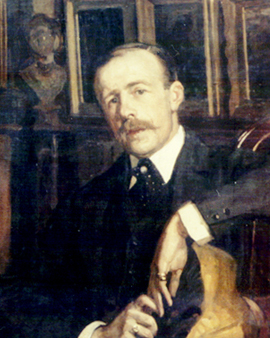Jacques Emile Blanche was the youngest of four children in a highly respected French family of doctors. His father Emile Blanche, like his grandfather, was a psychiatrist. Their famous clinic up in Montmartre was reserved for a very select clientele. The Blanche family themselves also lived on the premises of the clinic and maintained contact with the patients. As Jacques Emile's older siblings died very early, his parents cared for him all the more, as they feared they too could lose him. So he grew up as an only child and was never left out of his mother's sight. Blanche therefore did not grow up like a normal boy with playmates. His mother regularly took him to her Sunday salons, where she met and exchanged ideas with famous artists and great minds of her time. Thus the boy made his first acquaintances with Edgar Degas, Henri Fantin-Latour and listened attentively to the adult conversations. His education was therefore very unusual in this sense. He received an organized, classical school education for the first time at the age of 12. His artistic education also began at this age. His parents hired Edmond Maître as an art teacher. Maître is said to have later introduced Blanche to Claude Monet, whom he deeply admired. Maître also laid the foundation for Blanche's remarkable art collection. He convinced him to acquire his first works from Monet and Cézanne.
At the age of 18, Blanche met Pierre-Auguste Renoir, whom his mother had commissioned to paint some decorative panels in her new house. A little to the horror of his mother, Blanche became friends with the older Renoir and wished to be allowed to apprentice with him. His mother, however, found the Impressionists too "ordinary" and not academic enough for her son's education. She sent him instead to Henri Gevex, a good friend of the family. The 1880s were very important for Blanche's career and he described this year as his happiest. His first painting for the Paris Salon, "Young Woman on the Deck of a Boat" was accepted at this time. Blanche travelled regularly between Paris and London, his second home. Although Blanche received some lessons in his youth, he was considered more of an autodidact and was a real all-rounder. He was not only a talented painter but also a great writer. He later took some teaching posts and became from 1902 the director of the Académie de la Palette. Although Blanche also painted some still lifes and landscape scenes, he received the greatest recognition as a portraitist. Aristocrats, the moneyed aristocracy and artist colleagues enjoyed sitting for him as models.
×





_Blanc_-_(MeisterDrucke-982600).jpg)
_Blanc_-_(MeisterDrucke-982600).jpg)
.jpg)
.jpg)
.jpg)
.jpg)
_1911_-_(MeisterDrucke-130372).jpg)
_1911_-_(MeisterDrucke-130372).jpg)
_-_(MeisterDrucke-1172730).jpg)
_-_(MeisterDrucke-1172730).jpg)
.jpg)
.jpg)
_and_Florence_Halev_-_(MeisterDrucke-946058).jpg)
_and_Florence_Halev_-_(MeisterDrucke-946058).jpg)
 1892 - (MeisterDrucke-121913).jpg)
 1892 - (MeisterDrucke-121913).jpg)
.jpg)
.jpg)
.jpg)
.jpg)
 1913 - (MeisterDrucke-143653).jpg)
 1913 - (MeisterDrucke-143653).jpg)
_-_(MeisterDrucke-1090404).jpg)
_-_(MeisterDrucke-1090404).jpg)
.jpg)
.jpg)
.jpg)
.jpg)
.jpg)
.jpg)
 c1887 - (MeisterDrucke-191505).jpg)
 c1887 - (MeisterDrucke-191505).jpg)
 1915 - (MeisterDrucke-121822).jpg)
 1915 - (MeisterDrucke-121822).jpg)
 1923 - (MeisterDrucke-133885).jpg)
 1923 - (MeisterDrucke-133885).jpg)
.jpg)
.jpg)
_of_Mozart_Character_of_the_opera_The_wedding_of_Figaro_-_(MeisterDrucke-985177).jpg)
_of_Mozart_Character_of_the_opera_The_wedding_of_Figaro_-_(MeisterDrucke-985177).jpg)
_(oi_-_(MeisterDrucke-1171109).jpg)
_(oi_-_(MeisterDrucke-1171109).jpg)
 1919 - (MeisterDrucke-126300).jpg)
 1919 - (MeisterDrucke-126300).jpg)
.jpg)
.jpg)
.jpg)
.jpg)
 1921 - (MeisterDrucke-122686).jpg)
 1921 - (MeisterDrucke-122686).jpg)
.jpg)
.jpg)
_French_poet_Painting_by_Jacques_Emile_(Jacques_-_(MeisterDrucke-970066).jpg)
_French_poet_Painting_by_Jacques_Emile_(Jacques_-_(MeisterDrucke-970066).jpg)
.jpg)
.jpg)
_in_ballet_Fire_Bird_composed_by_Igor_-_(MeisterDrucke-948280).jpg)
_in_ballet_Fire_Bird_composed_by_Igor_-_(MeisterDrucke-948280).jpg)
.jpg)
.jpg)
 - (MeisterDrucke-121167).jpg)
 - (MeisterDrucke-121167).jpg)
.jpg)
.jpg)
.jpg)
.jpg)
 - (MeisterDrucke-141751).jpg)
 - (MeisterDrucke-141751).jpg)
.jpg)
.jpg)
 Countess of Castiglione Memory of 1893 1914 - (MeisterDrucke-128316).jpg)
 Countess of Castiglione Memory of 1893 1914 - (MeisterDrucke-128316).jpg)
 1924 - (MeisterDrucke-125088).jpg)
 1924 - (MeisterDrucke-125088).jpg)
_(oil_on_card)_-_(MeisterDrucke-583001).jpg)
_(oil_on_card)_-_(MeisterDrucke-583001).jpg)
.jpg)
.jpg)
_Painting_by_-_(MeisterDrucke-982668).jpg)
_Painting_by_-_(MeisterDrucke-982668).jpg)
.jpg)
.jpg)
 at his Piano - (MeisterDrucke-197168).jpg)
 at his Piano - (MeisterDrucke-197168).jpg)
.jpg)
.jpg)
 and his Friends at the Cafe Maure of the Exposition Universelle of 1900 1901 - (MeisterDrucke-134112).jpg)
 and his Friends at the Cafe Maure of the Exposition Universelle of 1900 1901 - (MeisterDrucke-134112).jpg)
 1923 (oil on card) - (MeisterDrucke-117784).jpg)
 1923 (oil on card) - (MeisterDrucke-117784).jpg)
.jpg)
.jpg)
.jpg)
.jpg)
_-_(MeisterDrucke-222774).jpg)
_-_(MeisterDrucke-222774).jpg)
_Blanche_(1861-1942)_French_painter_Pai_-_(MeisterDrucke-1002881).jpg)
_Blanche_(1861-1942)_French_painter_Pai_-_(MeisterDrucke-1002881).jpg)
.jpg)
.jpg)
.jpg)
.jpg)
.jpg)
.jpg)
 1924 - (MeisterDrucke-141384).jpg)
 1924 - (MeisterDrucke-141384).jpg)
.jpg)
.jpg)
.jpg)
.jpg)
_(1882-1971)_composer_Painting_b_-_(MeisterDrucke-999936).jpg)
_(1882-1971)_composer_Painting_b_-_(MeisterDrucke-999936).jpg)
 1920 - (MeisterDrucke-126568).jpg)
 1920 - (MeisterDrucke-126568).jpg)
 1924 - (MeisterDrucke-140436).jpg)
 1924 - (MeisterDrucke-140436).jpg)
.jpg)
.jpg)
_Painting_by_Jacqu_-_(MeisterDrucke-964272).jpg)
_Painting_by_Jacqu_-_(MeisterDrucke-964272).jpg)
.jpg)
.jpg)
_Painting_by_Jacque_-_(MeisterDrucke-951762).jpg)
_Painting_by_Jacque_-_(MeisterDrucke-951762).jpg)
.jpg)
.jpg)
.jpg)
.jpg)
.jpg)
.jpg)
.jpg)
.jpg)
.jpg)
.jpg)
.jpg)
.jpg)
.jpg)
.jpg)
 1935 - (MeisterDrucke-238427).jpg)
 1935 - (MeisterDrucke-238427).jpg)
_-_(MeisterDrucke-1313150).jpg)
_-_(MeisterDrucke-1313150).jpg)
.jpg)
.jpg)
.jpg)
.jpg)
.jpg)
.jpg)
.jpg)
.jpg)
.jpg)
.jpg)
.jpg)
.jpg)
.jpg)
.jpg)
.jpg)
.jpg)
.jpg)
.jpg)
.jpg)
.jpg)
.jpg)
.jpg)
_-_(MeisterDrucke-1102360).jpg)
_-_(MeisterDrucke-1102360).jpg)
 1912 - (MeisterDrucke-135400).jpg)
 1912 - (MeisterDrucke-135400).jpg)
_-_(MeisterDrucke-1019864).jpg)
_-_(MeisterDrucke-1019864).jpg)
.jpg)
.jpg)
.jpg)
.jpg)
_Painting_by_Jacques_Emile_(J_-_(MeisterDrucke-1026132).jpg)
_Painting_by_Jacques_Emile_(J_-_(MeisterDrucke-1026132).jpg)
.jpg)
.jpg)
.jpg)
.jpg)
.jpg)
.jpg)
 1912 - (MeisterDrucke-127542).jpg)
 1912 - (MeisterDrucke-127542).jpg)
_French_writer_Painting_by_Jacques_Emile_(J_-_(MeisterDrucke-998900).jpg)
_French_writer_Painting_by_Jacques_Emile_(J_-_(MeisterDrucke-998900).jpg)
 - (MeisterDrucke-129587).jpg)
 - (MeisterDrucke-129587).jpg)
.jpg)
.jpg)
 1931 - (MeisterDrucke-129369).jpg)
 1931 - (MeisterDrucke-129369).jpg)
_French_writer_Painting_by_Ja_-_(MeisterDrucke-998901).jpg)
_French_writer_Painting_by_Ja_-_(MeisterDrucke-998901).jpg)
.jpg)
.jpg)
.jpg)
.jpg)
 19th July 1920 - (MeisterDrucke-120628).jpg)
 19th July 1920 - (MeisterDrucke-120628).jpg)






